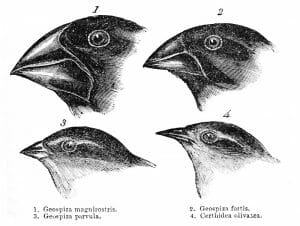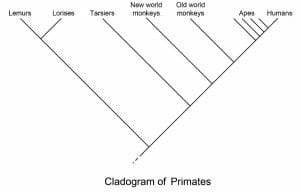Divergent Evolution Definition
Divergent evolution is the process whereby groups from the same common ancestor evolve and accumulate differences, resulting in the formation of new species.
Divergent evolution may occur as a response to changes in abiotic factors, such as a change in environmental conditions, or when a new niche becomes available. Alternatively, divergent evolution may take place in response to changes in biotic factors, such as increased or decreased pressure from competition or predation.
As selective pressures are placed upon organisms, they must develop adaptive traits in order to survive and maintain their reproductive fitness. Differences may be minor, such as the change in shape, size or function of only one structure, or they may be more pronounced and numerous, resulting in a completely different body structure or phenotype.
Divergent evolution leads to speciation, and works on the basis that there is variation within the gene pool of a population. If a reproductive barrier separates two groups within a population, different genes controlling for various aspects of an organism’s ability to survive and reproduce increase or decrease in frequency as gene flow is restricted. Allopatric speciation and peripatric speciation occur when the reproductive barrier is caused by a physical or geographical barrier, such as a river or mountain range. Alternatively, sympatric speciation and parapatric speciation take place within the same geographical area.
Through divergent evolution, organisms may develop homologous structures. These are anatomically similar structures, which are present in the common ancestor and persist within the diverged organisms, although have evolved dissimilar functions.
The image shows an example of the homologous bones found in the forelimb of four different types of mammal.
It is generally speculated that a greater number of differences between related species indicates more time since they underwent divergence. However, there are instances whereby unrelated organisms independently evolve analogous structures with similar appearance or function. This is known as convergent evolution.
Examples of Divergent Evolution
Darwin’s Finches
One of the most famous examples of divergent evolution was observed by Charles Darwin, and documented in his book On the Origin of Species.
Upon visiting the Galapagos Islands, Darwin noted that each of the islands had a resident population of finches belonging to the same taxonomic family. However, the bird populations on each island differed from those on nearby islands in the shape and size of their beaks.
Darwin suggested that each of the bird species had originally belonged to a single common ancestor species, which had undergone modifications of its features based on the type of food source available on each island. For example, the birds that fed on seeds and nuts evolved large crushing beaks, while cactus eaters developed longer beaks, and finer beaks evolved in birds that fed by picking insects out of trees.
When the ancestral form of finches initially colonized each island, each group contained individuals who were able to better adapt to the conditions and the available food source. These individuals survived and reproduced in their new habitat. In doing so, the genes that controlled for certain favorable aspects (e.g., longer beaks suitable for accessing nectar deep inside flowers) were spread throughout the gene pool, while the individuals without favored features died out. This is the process of natural selection.
The case of ‘Darwin’s Finches’ (the birds actually belong to the tanager family and are not true finches) is an example of adaptive radiation, which is a form of divergent evolution.

Adaptive radiation is a common feature in archipelagos such as the Galapagos Islands and Hawaii, as well as on metaphorical ‘island habitats’ such as mountain ranges. This is because gene flow between islands is limited when migration is not constant; however, the scale of the effect depends on the dispersal ability of the organism.
The Evolution of Primates
All of the primates on Earth evolved from a single common ancestor, most likely a primate-like, insectivore mammal, which lived around 65 million years ago in the Mesozoic Era. At that time, the world’s continents were mostly connected. Fossil evidence suggests that these primitive animals lived an arboreal life, with good eyesight and hands and feet adapted to climbing through trees.
Around 55 million years ago, the first true primates evolved, diverging into the prosimians and simians.
Ancestral prosimians mostly resembled modern prosimians, which include the lemurs (endemic to Madagascar), lorises, tarsiers and bush babies. These are small-brained and relatively small-bodied, with a wet nose similar to that of a dog. They are often nocturnal, with body features that are considered ‘primitive’, compared to other primates.
The next big divergence occurred around 35 million years ago in the other phylogenetic branch of primates, the simians. This event resulted in the divergence of the common ancestor of all New World monkeys and Old World monkeys.
It is speculated that the two groups underwent divergent evolution as a consequence of allopatric speciation. As the continents of America and Eurasia had by this point separated, the split could have been caused by a chance migration across the Atlantic Ocean.
The New World monkeys or Platyrrhines, are native to Central and South America, as well as Mexico. They evolved flat noses and prehensile tails, which act as a fifth limb and have the ability to grasp on to trees and branches. These include familiar families such as capuchins and spider monkeys (family: Cebidae), marmosets (Callitrichidae), and howler monkeys (Atelidae).
The common ancestor of the Old World monkeys and apes split around 25 million years ago. Old World monkeys, or Catarrhini, are native to Africa and Asia, displaying a range of different adaptions to many types of habitat, from rainforests to savannah, mountains and shrubs. There are both terrestrial and arboreal Catarrhini, many of which are familiar, such as macaques genus: Macaca), baboons (Papio) and langurs (Semnopithecus).
The apes, or Hominoidea, further diverged into two groups: the lesser apes, such as gibbons (family: Hylobatidae), which are all native to Asia, and the great apes (Hominidae), which are native to Europe, Africa and Asia, and include orangutans (genus: Pongo), gorillas (Gorilla), chimpanzees (Pan) and humans (Homo).
It is important to remember that the modern primates we see today are not evolved from each other despite their similarities (for example, great apes are not evolved from lesser apes), but that they are descended from a single common ancestor that formed two different species through divergent evolution.

The Kit Fox and the Arctic Fox
Two species that are very closely related and have undergone divergent evolution are the kit fox (Vulpes macrotis) and the Arctic fox (Vulpes lagopus).
The kit fox is native to Western North America, and is adapted to desert environments; it has sandy coloration, and large ears, which help it to remove excess body heat.
The Arctic fox is native to Arctic regions and lives in the Arctic tundra biome of the Northern Hemisphere. Best adapted to cold climates, it has thick fur, which is white in the winter and brown in the summer, and a small, round body shape that minimizes heat loss.
Having diverged from a recent common ancestor, both these species have had to adapt to their extremely different habitats. They have evolved into two species that are clearly very distinct in terms of their ears and coats, although they still retain the majority of their ancestral features.
Related Biology Terms
- Convergent Evolution – The process whereby species that are not closely related, independently evolve functionally or visually similar structures.
- Parallel Evolution – The process in which related, but distinct, species independently evolve similar structures.
- Speciation – The process in which new and distinct species are formed.
- Natural Selection – The process in which species that are better adapted to their environment survive and reproduce, whereas those that are maladapted do not.
Quiz
1. The structures present in the common ancestor of two species and that persist in their evolved lineage, albeit with a different form or function, are known as:
A. Analogous Structures
B. Homologous Structures
C. Divergent Structures
D. Vestigial Structures
2. The adaptive radiation seen in the case of the Galapagos finches is a result of:
A. High incidence of migration between islands
B. The development of analogous structures
C. Populations of birds adapting to fill available niches
D. All of the above
3. Which of the following statements is true?
A. Humans are more evolved than chimpanzees
B. New World monkeys evolved from Old World Monkeys
C. Gorillas and Lemurs share a common ancestor
D. Simians evolved from prosimians

